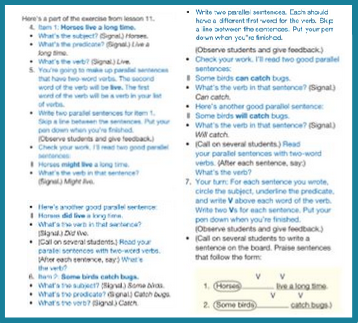Teach Reading Mastery Signature Edition: Language Arts: Year 3, 4 and 5
-
Module Introduction5 Topics
-
Overview22 Topics|1 Test
-
Cover
-
Lesson Objective
-
Opening the lesson
-
Direct Instruction overview
-
Who is it for
-
Program components
-
RMSE-LA 3 placement test specifics
-
RMSE-LA 4-5 placement test specifics
-
Placement test RMSE-LA 4
-
Grouping and seating
-
Teacher’s role in motivation
-
Affirmations
-
Teacher’s guides
-
Teacher’s guides continued
-
Script features
-
Star rules
-
Teacher-student game
-
Teacher-student game
-
Transitions
-
Check your understanding
-
Review
-
Lesson complete!
-
Cover
-
Managing Writing Activities23 Topics|1 Test
-
Cover
-
Lesson Objective
-
Opening the lesson
-
Managing writing activities explained
-
RMSE-LA 3 before students write
-
As students write
-
RMSE-LA 4-5 students’ oral reading of their writing
-
RMSE-LA 3 students check their passages
-
RMSE-LA 4-5 revising and editing
-
RMSE-LA 3 marking papers
-
RMSE-LA 4-5 marking papers
-
RMSE-LA 5 marking papers
-
Using the answer key in RMSE-LA 4-5
-
Positive praise
-
Specific praise
-
Using specific positive praise
-
Auditory signal
-
Auditory signal
-
Pacing of instruction
-
Pacing of instruction
-
Check your understanding
-
Review
-
Lesson Complete!
-
Cover
-
Parts of Speech and Sentence Analysis21 Topics|1 Test
-
Cover
-
Lesson Objective
-
Opening the lesson
-
Parts of speech and sentence analysis
-
Subject-predicate in RMSE-LA 3
-
Subject-predicate in RMSE-LA 4-5
-
Corrections
-
RMSE-LA 3 verb usage and identifying verbs
-
RMSE-LA 4 Verb agreement
-
Nouns
-
RMSE-LA 5 conjunctions, contractions and combining sentences
-
RMSE-LA 5 subject-verb agreement and two-word adjectives
-
RMSE-LA 3 pronoun usage
-
RMSE-LA 4 punctuation
-
RMSE-LA 3 pronouns, nouns and adjectives as parts of speech
-
RMSE-LA 5 nouns in the predicate, pronouns and pronoun case
-
Script success
-
RMSE-LA 5 Questions and Statements, adjectives and using position
-
Check your understanding
-
Review
-
Lesson Complete!
-
Cover
-
Clarity and General/Specific22 Topics|1 Test
-
Cover
-
Lesson Objective
-
Opening the lesson
-
Clarity in RMSE-LA 3-A
-
Clarity in RMSE-LA 3-B
-
Pause and punch
-
Clarity in RMSE-LA 4
-
Pronoun clarity
-
General/specific in RMSE-LA 4
-
Independent Work
-
Following directions – figure construction
-
Writing directions – figures and maps – 1
-
Active monitoring
-
Active monitoring
-
Unclear words
-
Unclear this/that
-
Phrase placement
-
Clear directions
-
General/specific
-
Check your understanding
-
Review
-
Lesson Complete!
-
Cover
-
Mechanics, Editing, Reporting and Inferring in RMSE LA 318 Topics|1 Test
-
Sentence Types and X Boxes17 Topics|1 Test
-
Cover
-
Lesson Objective
-
Opening the lesson
-
The tick
-
Sentence types
-
Statements consistent with impressions
-
Combining sentences
-
Comparative sentences
-
More sentence types
-
Pause and punch
-
Droning and corrections
-
X boxes for directions
-
Different X box format for directions
-
X-boxes format for claims
-
Check your understanding
-
Review
-
Lesson Complete!
-
Cover
-
Arguments and Passage Writing18 Topics|1 Test
-
Cover
-
Lesson Objective
-
Opening the lesson
-
Arguments described
-
False dilemmas
-
Infer missing evidence
-
Faulty arguments
-
Accordion box
-
Arguments continued
-
Script success
-
Corrections
-
RMSE-LA 4-5 revising and editing
-
Narrative writing
-
Extended passage writing symbols
-
Extended passage writing
-
Check your understanding
-
Review
-
Lesson Complete!
-
Cover
-
Retell and Parallel Construction20 Topics|1 Test
-
Cover
-
Lesson Objective
-
Opening the lesson
-
Retell overview
-
Prompted retells
-
Taking notes for retell
-
Using category words
-
Auditory signal
-
Auditory signal
-
Teacher demonstrating errors when signalling
-
Parallel construction – using also
-
Using only
-
Vocabulary
-
Descriptions
-
Deductions
-
Writing the missing sentence
-
Pacing of instruction
-
Check your understanding
-
Review
-
Lesson Complete!
-
Cover
-
Expanded Writing Process, Writing and Research Unit19 Topics|1 Test
-
Cover
-
Lesson Objective
-
Opening the lesson
-
Expanded writing process
-
RMSE-LA 3 marking papers
-
Expanded writing process continued
-
RMSE-LA 3 students check their passages
-
Writing and research unit
-
RMSE-LA 4-5 marking papers
-
Writing and revising stories
-
RMSE-LA 4-5 revising and editing
-
Writing reports and giving speeches
-
Reference materials
-
Study skills
-
Vocabulary
-
Punctuation and grammar
-
Check your understanding
-
Review
-
Lesson Complete!
-
Cover
-
Writing and Response To Literature16 Topics|1 Test
-
Cover
-
Lesson Objective
-
Opening the lesson
-
Writing
-
Inaccuracies
-
Misleading claims
-
Contradictions
-
Inadequate evidence
-
Mystery object
-
False cause and arguments with conclusions that are too general
-
Hypothesis testing
-
More-probable inferences and planning/decisions
-
Response to literature
-
Check your understanding
-
Review
-
Lesson Complete!
-
Cover
-
Extensions, Further Activities and Projects14 Topics|1 Test
-
Cover
-
Lesson Objective
-
Opening the lesson
-
Language Arts extensions
-
Using resource materials and study skills
-
Usage and grammar, word analysis and word-analysis extensions
-
Positive praise
-
Further activities
-
Specific praise
-
Using specific positive praise
-
Projects (team activities)
-
Check your understanding
-
Review
-
Lesson Complete!
-
Cover
-
Program Assessments22 Topics
-
Cover
-
Lesson Objective
-
Opening the lesson
-
Mastery tests
-
Conducting mastery tests
-
Scoring the test
-
Using mastery test information
-
Mastery test criterion
-
Providing test remedies
-
Remediation and retesting how it is done
-
Mastery tests on SPT
-
Inputting data on SPT
-
Flight path concept
-
Expected lesson pacing
-
Lesson progress on SPT
-
Pacing of instruction
-
Effective transitions
-
Teaching routines for effective transitions
-
Teaching routines
-
Teaching and reinforcing routines and expectations
-
Review
-
Lesson Complete!
-
Cover
-
Module Completion Survey1 Topic
Participants 580

Nouns
Noun/verb
Students learn to create parallel sentences that have two-word verbs in place of one-word verbs in lesson eleven. To create the parallel sentences, students use a list of helping verbs.

Nouns-not nouns in the subject
In lesson seven students learn that some subjects do not have nouns. Rather, the subjects consist of a pronoun.
Two-word verbs
Students learn to create parallel sentences that have two-word verbs in place of one-word verbs in lesson eleven. To create the parallel sentences, students use a list of helping verbs.
Turn to page 35 in RMSE-LA 5 Teacher’s Guide. Practise lesson 11 twice with your partner, once with no student errors and once with student errors. Read and review teaching notes and lessons on page 34-36.
The process
The process is:
- The teachers says, ‘Item one: Horses live a long time. What’s the subject?’ and signals (auditory). ‘What’s the predicate?’ and signals (auditory). ‘What’s the verb?’ and signals (auditory).
- The teacher says, ‘You’re going to make up parallel sentences that have two-word verbs. The second word of the verb will be live. The first word of the verb will be a verb in your list of verbs. Write two parallel sentences. Put your pen down when you’re finished’ and observes students and provides feedback.
- The teacher says, ‘check your work. I’ll read two good parallel sentences: Horses might live a long time. What’s the verb in that sentence?’ and signals (auditory).
- The teacher says, ‘Here’s another good parallel sentence: Horses did live a long time. What’s the verb in that sentence?’ and signals (auditory).
- The teacher calls on several students and says, ‘Read your parallel sentences with two-word verbs.’ After each sentence the teacher says, ‘What’s the verb?’


